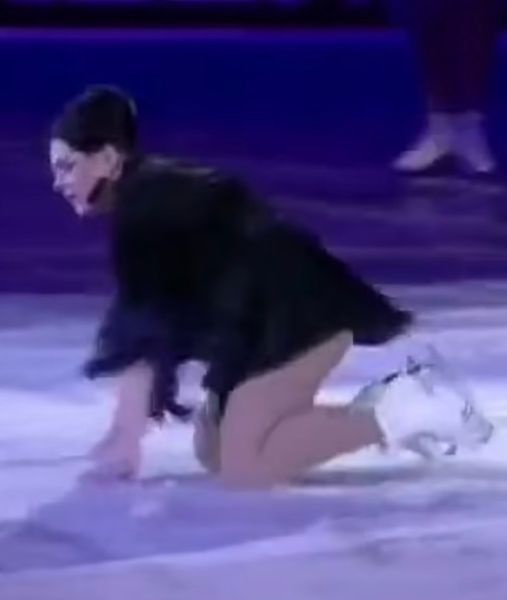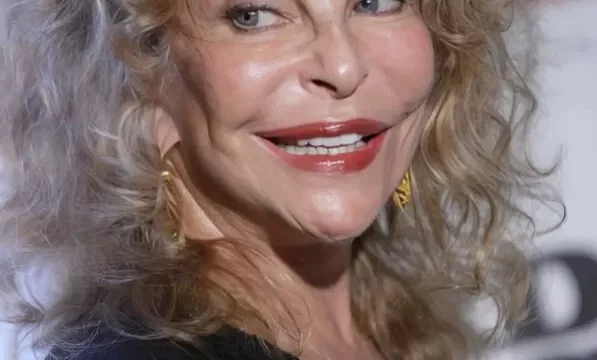At the European Figure Skating Championships in Finland, the world witnessed a groundbreaking moment that sparked a mix of admiration, reflection, and debate. Minna-Maaria Antikainen, the first transgender figure skater to perform at the event, took to the ice during the opening ceremony. The performance, marked by an unplanned fall, quickly went viral and became a focal point for discussions about inclusivity in the world of figure skating.

Antikainen, formerly known as Markku-Pekka Antikainen, is a 57-year-old farm owner from Siilinjarvi, Finland. Embracing figure skating at the age of 49, Antikainen’s late start in the sport added to the intrigue surrounding their debut. This solo performance was organized by the Finnish Figure Skating Association as part of a broader initiative aimed at promoting diversity, equality, and inclusion within the sport—a mission that resonated deeply with the theme of this year’s opening ceremony, “Just Be You.”
However, the debut didn’t go as smoothly as planned. Shortly after starting the routine, nerves appeared to take over, and Antikainen stumbled and fell on the ice. The moment, while brief, was significant. A female hostess carrying the Finnish flag quickly rushed to Antikainen’s side, helping them recover and continue the performance. The stumble, though unintended, has since become a symbolic moment, drawing widespread attention and sparking discussions about the challenges faced by athletes breaking traditional norms in their respective sports.
According to Finnish news outlets, Antikainen identifies as a gender-neutral woman and has openly shared their journey in figure skating. Despite this setback, their dedication to the sport is undeniable. Antikainen reportedly trains on the ice for five hours each week and has participated in several competitions both domestically and internationally leading up to the championship. Their persistence and passion have drawn support and sympathy from many, especially considering Antikainen’s childhood dream of becoming an “ice princess,” as reported by Reduxx Magazine, a platform advocating for women and children’s safeguarding.
The opening ceremony itself was designed to underscore the importance of equality and diversity in figure skating. The Finnish Figure Skating Association used the event to shine a light on the sport’s potential for inclusivity, even as it faces ongoing debates about its conservative nature. One such issue is the ban on same-sex skating pairs in international competitions. Currently, figure skating adheres to traditional rules that define pairs as male and female, leaving no specific categories for non-binary or gender-diverse skaters.
Outi Wuorenheimo, the Executive Director of the Finnish Figure Skating Association, spoke candidly about the rigid structure of the sport. Wuorenheimo acknowledged the strict rules governing international competitions and expressed a desire for the global figure skating community to evolve. In her view, fostering equality and diversity should be at the forefront of future discussions, allowing the sport to embrace participants from all backgrounds and identities.
Antikainen’s performance, though marked by a stumble, has sparked broader conversations about the challenges and opportunities in creating a more inclusive environment within the sport. The fall served as a metaphor for the hurdles faced by individuals who step into spaces that have long been bound by traditional structures. It also highlighted the courage required to challenge these norms and pave the way for future generations of athletes.
While some may focus on the fall itself, others see it as a powerful reminder of the human aspect of performance and the importance of perseverance. Moments like these encourage reflection on how sports can move toward a more accepting and diverse future. They also provide an opportunity for organizations, athletes, and fans alike to reconsider long-standing practices and explore ways to make the sport more welcoming for everyone.
The theme “Just Be You” was not just a tagline for the opening ceremony but a call to action for the figure skating community to embrace individuality and diversity. Antikainen’s performance, despite its imperfections, embodied the spirit of this message. It served as a powerful reminder that inclusivity isn’t just about representation but about creating spaces where everyone feels valued and supported.
As figure skating continues to grapple with its conservative roots, moments like Antikainen’s debut push the conversation forward. They challenge the sport to evolve and adapt to a changing world, where diversity and equality are becoming increasingly vital. Whether through adjusting rules to allow for same-sex pairs or creating new categories for non-binary skaters, there is a growing acknowledgment that the future of figure skating must be one of openness and inclusivity.
Antikainen’s fall may have been a fleeting moment, but its impact is far-reaching. It has ignited a dialogue that transcends the ice rink, addressing broader societal questions about acceptance and equality. More importantly, it stands as a testament to the courage of those who dare to be the first, knowing that their steps, no matter how imperfect, pave the way for others to follow.





